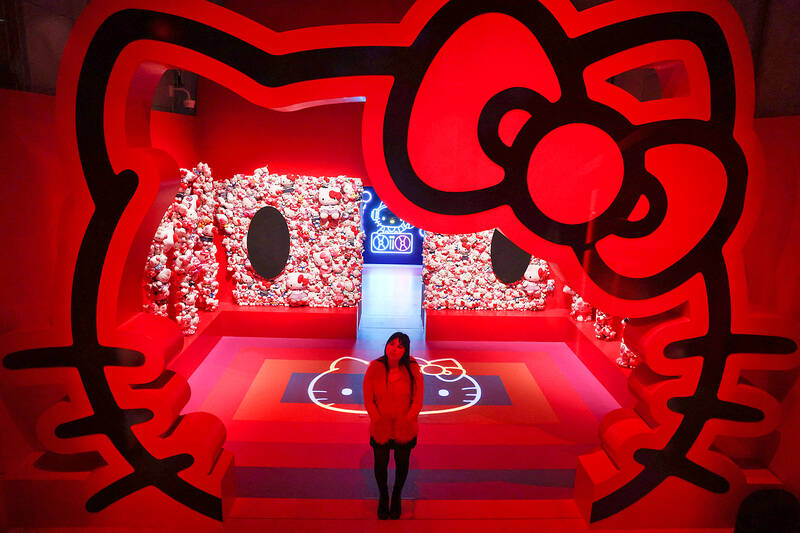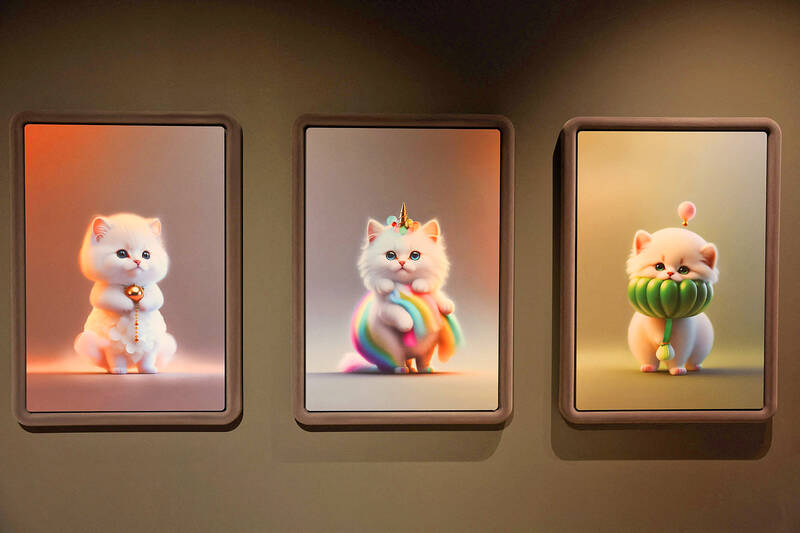From cats and plushies to emojis, a new central London exhibition which opened on Thursday is exploring the “irresistible force” of “cuteness.”
Even before the doors to “CUTE” opened at Somerset House, influencers in Japanese schoolgirl uniforms, Hello Kitty dresses and Pikachu hats playfully posed for photos to charm their social media followers.
The exhibition blends art with an array of musical clips, video games and memes from social media, exploring a largely virtual culture that has swept across the globe with the explosion of the Internet.

Photo: AFP
One room of CUTE is a tribute to cats, which make up some of the most viewed content on the Internet, contrasting 19th-century black-and-white feline photographs with futuristic artificial intelligence-generated rainbow kitten portraits.
Further on, a collage of curly-haired Renaissance cherubs — the original cute babies of art history — intermingles with plush toys, mangas and iconic figures from the kawaii (cute, 可愛) culture that emerged in 20th-century Japan.
For the exhibition’s curator, Claire Catterall, the concept of cute is so vast that she struggles to define it.

Photo: AFP
“The exhibition unpacks what cuteness is, so it’s a very slippery scene,” she said. “It’s very hard to define. It’s very tricky. And in many ways, that’s the power of it. It’s so many different things all at once.”
In sections divided by cat-shaped or rainbow arches, contemporary works share space with commercial products such as Tamagotchi toys or Sylvanian Family figures, reminding visitors that cuteness is a lucrative billion-dollar business.
The CUTE exhibition is sponsored by Japanese company Sanrio Co, which globally markets merchandise of the feline-inspired character Hello Kitty, created about 50 years ago.
Visitors meander under an archway adorned with the character’s likeness, walls blanketed in colorful plush toys, before shimmying under the Hello Kitty disco’s glitter ball.
“Cuteness and capitalism are so closely intertwined,” Catterall said. “There is this kind of quite queasy quality about that which makes people feel really uncomfortable.”
Although cuteness lives “within the capitalist structures which spawned it,” it could also be what disrupts it the most, she added.
The aesthetics of cuteness were once mocked or adopted ironically but its values and dress codes are now championed by many young people as they allow for an “existence outside the norms,” particularly for women and the queer community, Catterall said.
“I think for a long time, cuteness has been considered childish and inconsequential and not serious, but this exhibition will hopefully show that there’s so much more to it than that,” the curator said. “It’s actually really something to be taken seriously, and can tell us so many things about us and the world around it.”
CUTE also touches on a more political dimension of cuteness, in a section featuring a fuchsia pink balaclava from the Russian feminist punk band Pussy Riot, known for their provocative protests against Russian President Vladimir Putin.
As immersive exhibitions and museums proliferate worldwide, CUTE, open to the public until April 4, also emphasizes interactivity.
Visitors can enjoy vintage Japanese video games in an arcade room or relax at a “pyjama party” in a vast teen bedroom complete with bean bags and pop music, created by British artist Hannah Diamond.
“It’s exuberant, it’s exhilarating, it’s empowering,” Catterall said. “We wanted to create a space where people could come in, dance, feel really happy, cover themselves in Hello-Kitty-glow of goodness.”
Cuteness is not just an “aesthetic,” she said. “It’s a feeling.”

MULTIFACETED: A task force has analyzed possible scenarios and created responses to assist domestic industries in dealing with US tariffs, the economics minister said The Executive Yuan is tomorrow to announce countermeasures to US President Donald Trump’s planned reciprocal tariffs, although the details of the plan would not be made public until Monday next week, Minister of Economic Affairs J.W. Kuo (郭智輝) said yesterday. The Cabinet established an economic and trade task force in November last year to deal with US trade and tariff related issues, Kuo told reporters outside the legislature in Taipei. The task force has been analyzing and evaluating all kinds of scenarios to identify suitable responses and determine how best to assist domestic industries in managing the effects of Trump’s tariffs, he

TIGHT-LIPPED: UMC said it had no merger plans at the moment, after Nikkei Asia reported that the firm and GlobalFoundries were considering restarting merger talks United Microelectronics Corp (UMC, 聯電), the world’s No. 4 contract chipmaker, yesterday launched a new US$5 billion 12-inch chip factory in Singapore as part of its latest effort to diversify its manufacturing footprint amid growing geopolitical risks. The new factory, adjacent to UMC’s existing Singapore fab in the Pasir Res Wafer Fab Park, is scheduled to enter volume production next year, utilizing mature 22-nanometer and 28-nanometer process technologies, UMC said in a statement. The company plans to invest US$5 billion during the first phase of the new fab, which would have an installed capacity of 30,000 12-inch wafers per month, it said. The

Taiwan’s official purchasing managers’ index (PMI) last month rose 0.2 percentage points to 54.2, in a second consecutive month of expansion, thanks to front-loading demand intended to avoid potential US tariff hikes, the Chung-Hua Institution for Economic Research (CIER, 中華經濟研究院) said yesterday. While short-term demand appeared robust, uncertainties rose due to US President Donald Trump’s unpredictable trade policy, CIER president Lien Hsien-ming (連賢明) told a news conference in Taipei. Taiwan’s economy this year would be characterized by high-level fluctuations and the volatility would be wilder than most expect, Lien said Demand for electronics, particularly semiconductors, continues to benefit from US technology giants’ effort

‘SWASTICAR’: Tesla CEO Elon Musk’s close association with Donald Trump has prompted opponents to brand him a ‘Nazi’ and resulted in a dramatic drop in sales Demonstrators descended on Tesla Inc dealerships across the US, and in Europe and Canada on Saturday to protest company chief Elon Musk, who has amassed extraordinary power as a top adviser to US President Donald Trump. Waving signs with messages such as “Musk is stealing our money” and “Reclaim our country,” the protests largely took place peacefully following fiery episodes of vandalism on Tesla vehicles, dealerships and other facilities in recent weeks that US officials have denounced as terrorism. Hundreds rallied on Saturday outside the Tesla dealership in Manhattan. Some blasted Musk, the world’s richest man, while others demanded the shuttering of his